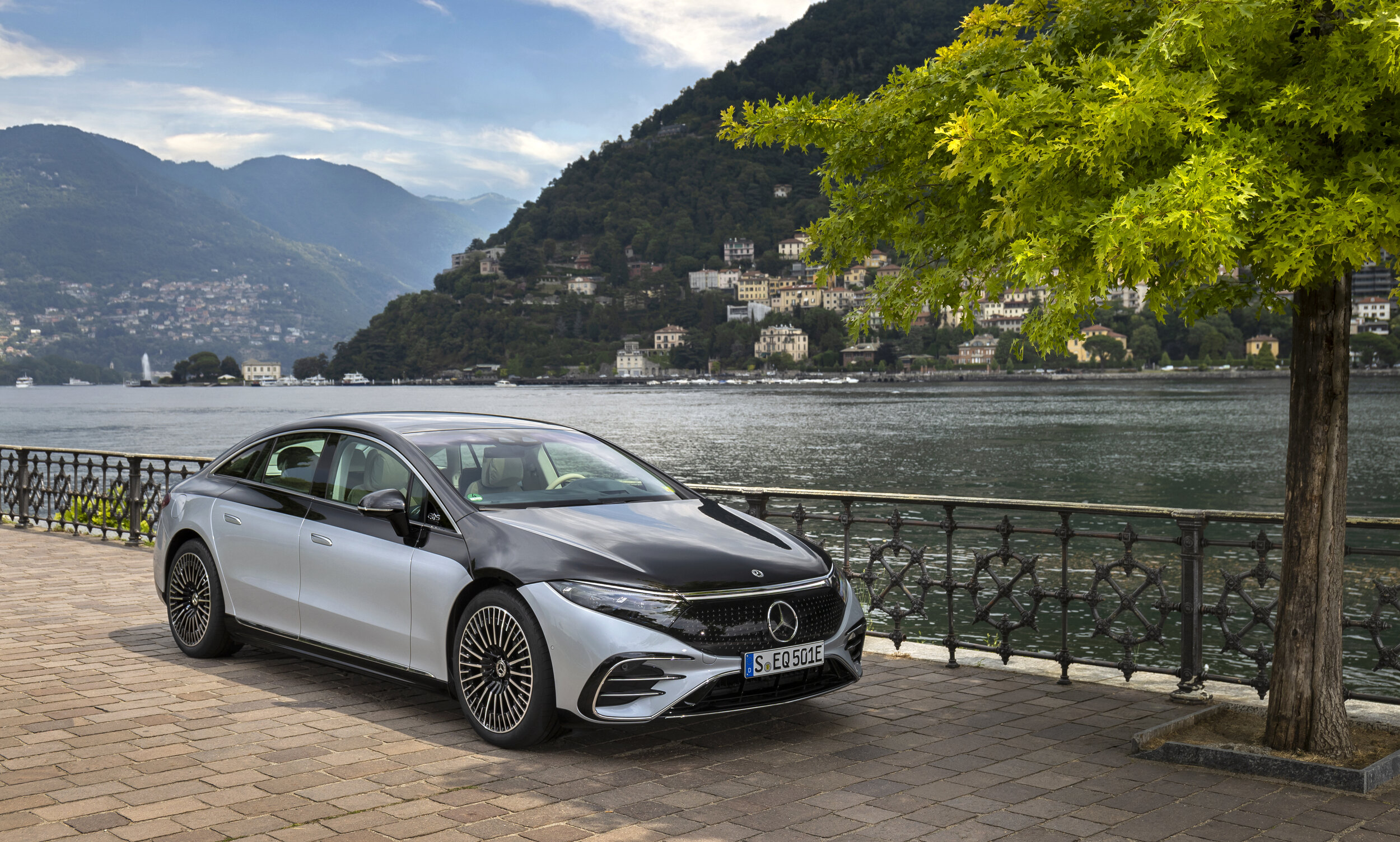Five Hours in a Mercedes-Benz EQS 580
Redefining a Classic
photography by Mercedes-Benz
For the person who has a healthy budget for a new car, a tendency to indulge in the latest luxury sedans, and who can’t stand to wait for the future, the 2022 Mercedes-Benz EQS is a solid choice.
The EQS is the first all-electric flagship sedan made by Mercedes-Benz. It follows the EQC, a small SUV available only in Europe. It’s Mercedes’ introduction of its important electric platform stateside, and a lot of rests on its North American welcome reception.
FROM THE OUTSIDE IN
EQS is one of the most enticing new vehicles to drive this year. It’s a take off on the traditional S-Class sedan, with its own twist. It’s wrapped in a fluid. bulbous exterior design, which is more polarizing than the stately S-Class. The exterior design harkens back to 2015 concept car language, but is less dynamic in its current form, and takes some getting used to. I haven’t fully decided how I feel about the exterior as a blueprint for its form language.
But no matter, because people will buy the EQS is what’s happening on the inside — it’s a game-changing interior and a joy to drive. As a total package, EQS is the statement car for right now.
“ The statement car for right now. ”
The choices for a fully electric luxury sedan are slim. There’s the Tesla Model S, a model that’s now a decade old design, the nascent sold-out Lucid Air Dream launch edition, or the Porsche Taycan, which has a very long waiting list. Christophe Starzynski, who heads the EQ brand, told me that Mercedes has kept the EQS out of the fray of its chip shortage, making it one of the few cars that isn’t unobtainable during these bizarre times. Driving EQS is also a chance to go first in a product that’s a reset for the world’s oldest car company.
I’ve spent time in the EQS twice. I drove a pre-production version in the spring. In early October, I spent five hours in an EQS, much of which was spent in San Francisco traffic, idling. I didn’t run low on juice for the battery-powered engine, never even came close.
SCREEN FOR DAYS
What stands out most about the EQS is its interior, one of the most comfortable cars I’ve been in to date. The driving experience is largely defined by it massive 56-inch hyperscreen, reminiscent of a home theater, with all the drama of lights, camera action on board. What offsets all that potential for screen glare is the open air vibe by the glass, allowing natural light to spill in. A soft pillow catches my head when I hit the gas, and I’m ready to enjoy a relaxing ride.
Everything goes down on this slate of screen that spans across the dashboard. I would stock the glove box with screen cleaner for starters. My passenger used their end of the screen to get the active massage function to work. If the screen is too overwhelming to pick up quickly, there’s always the option voice-command, making the hyperscreen a show piece in that use case. All the functions take some getting used to, but are not unmanageable. One bit of new tech that I struggled to get used to was the three-dimensional heads-up screen that sometimes felt like I confused for an object out of the side of my eye when turning. I’d skip this optional feature.
What I still would like to better understand is how its AI-features play out over time to assist the driver. Mercedes MBUX UX engineers tell me its studies driver behavior over time. How well does the car study my driving behavior over time? A few more days behind the wheel will tell. EQS is not for minimalists. Mercedes has thought of everything for the EQS, and it’s a car that makes for a conversation piece.
LUXURY PERFORMANCE AT WORK
EQS, like so many EVs, takes advantage of its power pack capabilities. Its super zippy, producing 560 horsepower and 631 pound-feet of torque. Its easy to maneuver the EQS in tight city spaces. The power makes it a pleasure to pilot on long stretches highways, and its tighter proportion means its easier to drive than an S-Class. The 580 model is all-wheel drive equipped. I almost blew past one highway exit and quick action on the brakes was responsive for my driving purposes. I didn’t assess EQS like a track car, but one that has real world performance applicaton. I tested the level-two self driving software on a stop and go section of San Francisco highway, where it allowed me drift a bit, and seemed on par with the current systems like Super Cruise.
I spent most time in the front seat, so can’t assess the rear passenger experience. Some have quibbled that Mercedes should follow the EV trend to make the front area equipped for more storage space — aka add a “frunk. Instead, Mercedes opted to install a HEPA air quality filter in that zone. As I drove around San Francisco and reflected on the constant threat posed by fire and smoke, this decision seems like the right one to me. In an era of eco-crises, every ride should have health-minded features. The existing trunk space is plentiful for the small family that might be in this car. I say leave the big cargo option for the seven-seater EQB that’s coming soon.
Quelling Range Anxiety
EVs have introduced a new language to car shoppers as reviewers become obsessed with miles-for-the-watts. For me, EV calculations reminds me of Algebra I logic problems in high school. Until I am out gas or planning a long trip, I don’t think about the amount of miles I’m traveling. I don’t think this is unique to me, as we rely on Google Maps to make our time and distance real-time traffic decisions. Here’s where I remind most people, when it comes to range anxiety: most commuters will rarely drive more than 50 miles a day. If you have a longer journey planned, access to charging depends on where you’re going. It’s a point worth noting, but there’s not much difference between 300 and 400 miles of range.
In October, Mercedes-Benz released official numbers for the 2022 Mercedes-Benz EQS The most power EQS, the 580, can travel 340 miles on a charge, and the 350 earns 350 miles per full charge. At a speed of 70 miles per hour, that’s five hours of driving time before running out of fuel completely. After five hours, everyone needs a break.
As more EV options become available, the range, or miles that the car can go on a single charge, becomes a key part of the storytelling. I often wonder if the language around that number, which can range from 17 miles on a MINI Cooper SE Countryman ALL4 plug-in hybrid (PHEV) to 560 miles on the top-of-the-line Lucid Air resonates with people who are brand new to a car that runs on batteries, not petroleum. Until people get used to electric calculations, these numbers are obtuse.
Back high school, I ran out of gas for the first and last time in my life. I was running late and ignored my mom’s reminders to fill up the car on the way to school, and did not heed the warnings after school on the way to visit a friend. I was convinced that “E” meant 20 more miles until something bad happened. I ended up on the side of the road. I remember that moment of profound dread when the car crawled to a stop in a remote part of town. I remember walking to a friend’s home a few miles away. I didn’t have a cell phone, so that was my only option. My friend’s dad took me to the gas station to fill up a tank and back to the car to get me on my way. The experience was humiliating, but effective. I never ran out of gas again.
It’s this dread of getting stuck that makes people nervous about making the switch to electric cars. When there’s no gas station in sight, how do you calculate risk to make the new daily configuration work in your favor? When I think about daily driving, I don’t calculate the miles in my head. I think about the time I spend going from place to place. When it comes to EV logic, what people are buying isn’t dollars on the gallon, but their time, and assurance they will never be left behind.
The EQS is equipped with enough systems and safe guards to help me problem solve if range does become an issue, and it’s a helper to track down accessible charging stations. If the infrastructure cooperates, and I can access charging stations, Mercedes-Benz says that 10-80% charging will take 31 minutes and that up to 174-186 miles of range can be replenished in just 15 minutes. I still think that the EQS is best-suited to an owner that can invest in dedicated driving until Electrify America can amp up better services. Its only the beginning for Mercedes EQ brand, which will add three EVs to its US portfolio over the next two years. Mercedes-Benz has been talking EVS for too long to start out sublty, with EQS, Mercedes kicks electric off it electrified product portfolio in style.


